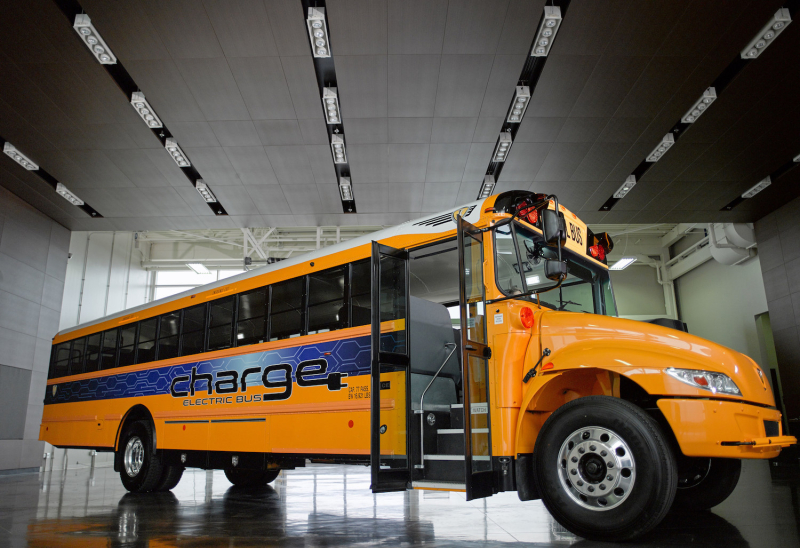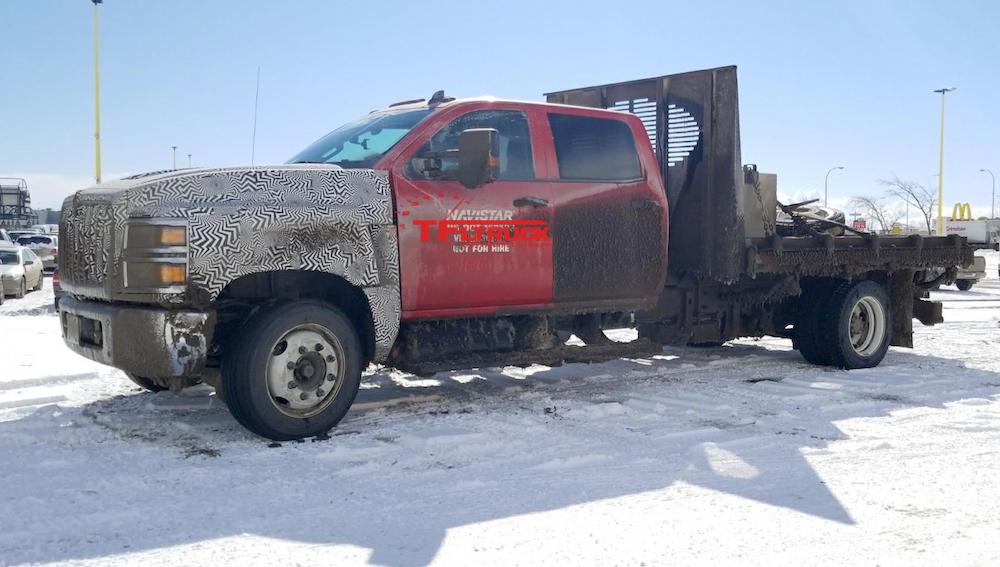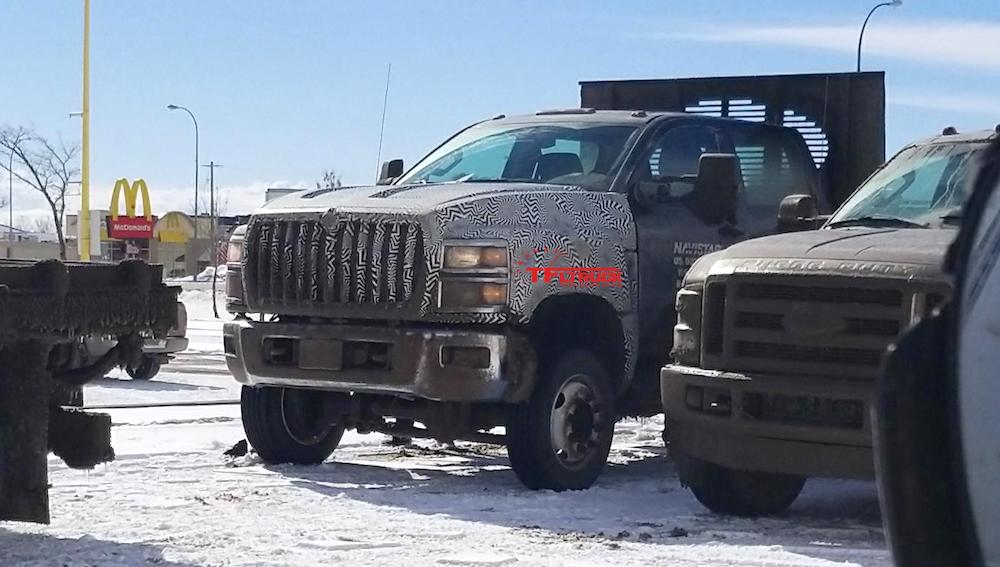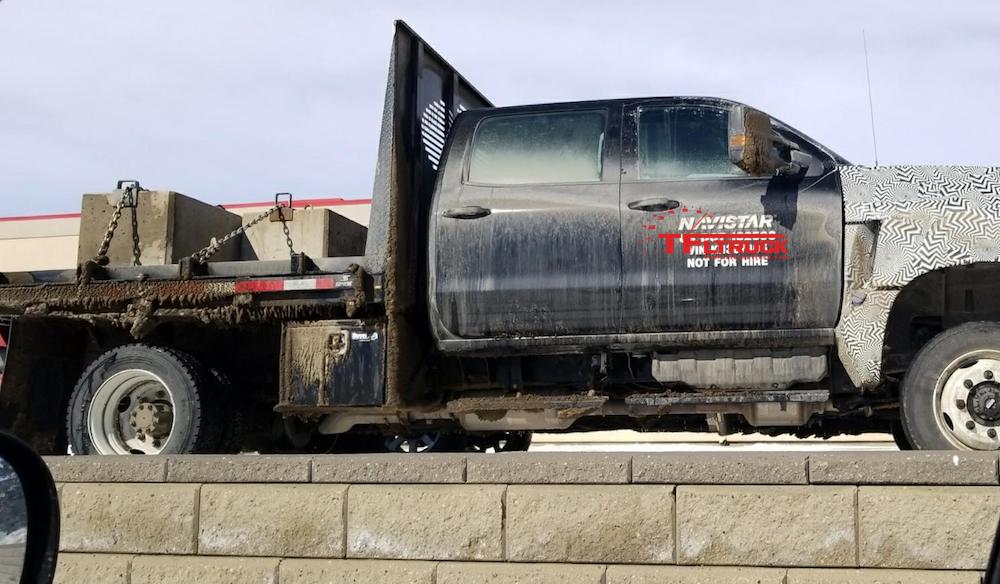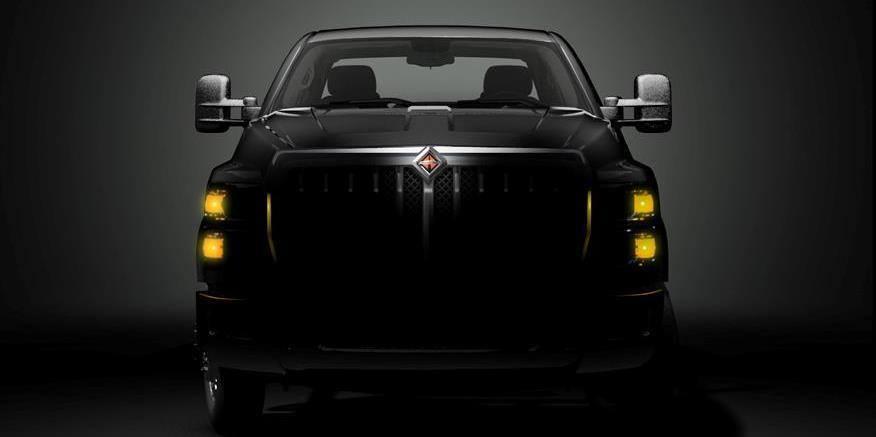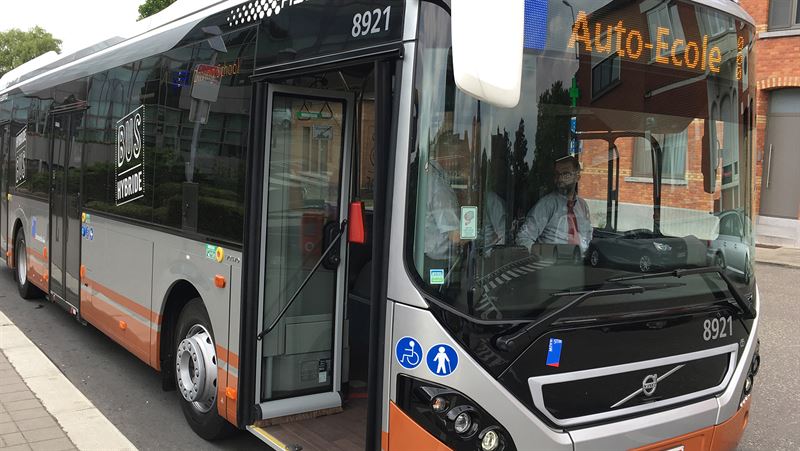
kscarbel2
Moderator-
Posts
18,915 -
Joined
-
Days Won
114
Content Type
Profiles
Forums
Gallery
Events
Blogs
BMT Wiki
Collections
Store
Everything posted by kscarbel2
-
Green Car Congress / March 25, 2018 IC Bus, a subsidiary of Navistar, is taking its electric school bus, chargE (earlier post), on the road for the first time. The 2018 national tour begins with its first stop at the California Association of School Transportation (CASTO) State Board of Directors 50th Annual Meeting in San Diego, California. The chargE concept electric school bus incorporates a common group electric drivetrain from Volkswagen Truck & Bus that is quiet, does not produce any emissions, and can be built to address any school bus customer’s specific requirements. The range of the chargE can exceed 120 miles (193 km), while the powertrain can deliver up to 260 kW (about 349 peak horsepower). As an early example of Navistar’s alliance with Volkswagen Truck and Bus, which will also include a previously announced electric medium-duty truck for the North American market, the chargE brings together multiple concepts and technologies that will shape the school bus of the future. It also includes camera technology, connected systems and remote diagnostics that support vehicle safety, uptime, and more efficient vehicle inspections. The company originally unveiled the chargE at the 2017 National Association for Pupil Transportation Annual Conference and Trade Show; the bus will be launched as early as late 2019 or early 2020. The chargE was designed to give customers a zero-emissions school bus option while lowering the total cost of ownership and offering user-friendly options. On the first leg of the tour, chargE will visit more than 10 locations throughout the West Coast to provide an opportunity for bus industry stakeholders to experience the electric IC Bus CE Series concept school bus developed with Navistar’s alliance partner, Volkswagen Truck & Bus. The national tour will include scheduled stops at trade shows, school visits, and local government events throughout the country, including locations in and around Sacramento, Seattle, San Francisco and Los Angeles, to provide customers with high-touch learning events with chargE. . .
-
-
The mid-size Transit Custom and Tourneo Custom. . . . . . . . .
-
Volvo Group Press Release / March 26, 2018 Volvo Group has entered into an agreement to divest a Chinese subsidiary, which is holding 25.2% of the shares in the Chinese company Inner Mongolia North Hauler Joint Stock Co., Ltd (NHL / 内蒙古北方重型汽车股份有限公司 - http://www.chinanhl.com/) for approximately SEK 0.9 billion. The transaction is subject to regulatory approvals and could be terminated by either party if regulatory procedures or changes in regulatory rules or laws preclude the parties from completing the transaction. The divestment is expected to generate a capital gain of approximately SEK 0.7 billion, which will affect the Volvo Group’s operating income when the transaction is closed. Closing of the transaction is expected within six months. The divestment will impact the Group’s cash flow and net financial position positively with an amount of approximately SEK 0.9 billion at closing. NHL, which is listed on the Shanghai Stock Exchange, produces and sells among other things rigid haulers to the mining industry. Volvo Construction Equipment will continue to sell components for rigid hauler production to NHL also after the divestment.
-
Scania Group Press Release / March 20, 2018 Scania’s net sales rose to a record high SEK 119.7 billion, an increase of 15 percent compared to the previous year. Truck deliveries reached an all-time-high and demand for our new truck range was good. Higher vehicle and service volume impacted earnings positively, offsetting higher production costs for running double product ranges, constraints in the supply chain and an unfavourable market mix. Summary of the full year 2017 Operating income, excluding items affecting comparability, amounted to SEK 12,434 m. (10,124) Operating income, amounted to SEK 12,434 m. (6,324) Net sales increased by 15 percent to SEK 119,713 m. (103,927) Cash flow amounted to SEK 5,701 m. (3,427) in Vehicles and Services Comments by Henrik Henriksson, President and CEO “Scania’s net sales rose to a record high SEK 119.7 billion, an increase of 15 percent compared to the previous year. Truck deliveries reached an all-time-high and demand for our new truck range was good. Higher vehicle and service volume impacted earnings positively, offsetting higher production costs for running double product ranges, constraints in the supply chain and an unfavourable market mix. Operating income in 2017 amounted to SEK 12.4 billion, which gave an operating margin of 10.4 percent. In 2017, vehicle orders surpassed the level of 100,000 for the first time due to the new truck generation and our global reach. Order bookings for trucks rose by 30 percent compared to the previous year. The strong demand for trucks continued in large parts of Europe. In Eurasia, Russia’s strong recovery is continuing. The trend in Latin America is positive with continued good demand in Argentina and a slight improvement in Brazil. In Asia, demand mainly increased in Iran and China. Order bookings in Buses and Coaches increased by 11 percent, mainly related to Russia and Iran. In the business area Engines, order bookings were strong in all segments. Growth in service volume continued and revenue amounted to a record high SEK 23.7 billion, an increase of 10 percent (8 percent in local currencies). With more than 300,000 connected vehicles in the fleet, Scania is able to continually improve its customer offering with increasingly efficient services for improved profitability. Financial Services reported its highest ever operating income of SEK 1.3 billion and credit losses remain at low levels. The introduction of the new truck generation is continuing. With the launch of trucks for long-haulage, construction and most recently trucks for urban traffic, Scania has unveiled all the products in the new truck family. The new fuel-efficient vehicles offer enhanced drivability, improved safety, ergonomics, comfort and even better overall economy. In 2017, more than 13,000 trucks were delivered from Scania’s new truck range. With an average reduction in fuel consumption of over five percent per vehicle, this will provide total estimated savings of more than 30,000 tonnes in global carbon emissions. During the fourth quarter, Scania also introduced a six-cylinder 13-litre gas engine specifically designed for long-haulage and unveiled its new Scania Citywide Low Floor bus, which is fully electrically-powered.” .
-
Daimler Trucks Press Release / March 22, 2018 Daimler Trucks. In all we do, our focus is on our customers. In order to offer them our best products and solutions, we work continuously on innovations. Our focus is on trucks that are efficient and electric,safe, automated and connected. .
-
Exactly, Mayflower is old history and Commercial Vehicle Group is Navistar's cab producer, as well as the Mack brands. Sheller-Globe purchased Motor Panels of the UK and then put the Norwalk Mack cab plant under its new Motor Panels division. Then that division was sold in 1989 to UK-based CH Industrials, which was sold in 1991 to UK-based Mayflower Vehicle Systems, which was sold in 2005 to Commercial Vehicle Group (CVG). FYI - The company, like Bendix who assembles Autocar (Xpeditor) cabs, had no prior history of assembling cabs.
-
. .
-
Volvo updates FE low-entry cab for more transport operations
kscarbel2 replied to kscarbel2's topic in Trucking News
The FL has been continually sold in the global market.............http://www.volvotrucks.com/en-en/trucks/volvo-fl.html Mack sold the Renault Midlum thru 2003 (badged as the Freedom), three years after Volvo acquired America's truckbuilding icon. The Kenworth K270/K370 and Peterbilt model 220 are loosely based on the global market DAF "LF", but aside from the cab "shell" have nothing in common with the Volvo FL. US models only offer the Cummins/Paccar PX-7, while the LF also offers the PX-5. -
Cabs For 2019 Silverado Medium Duty Trucks To Be Built At Navistar Body Shop Alex Luft, GM Authority / March 22, 2018 The cabs for the new 2019 Silverado Medium Duty trucks will be built by Navistar, GM Authority confirmed with Chevrolet officials. Contrary to popular belief, the cabs for the new beasts will be assembled at a new body shop at Navistar’s Springfield Assembly plant in Ohio, where the Silverado Medium Duty family is produced. Prior to this confirmation, it was rumored that the cabs will be built at the GM Fort Wayne plant in Indiana and transported to Navistar’s Springfield plant, located roughly 130 miles South East. In addition, Chevy tells us that the cabs the new Silverado Medium Duty trucks will be “very similar” to those used in the Silverado 2500HD and 3500HD models. GM/Chevrolet co-developed the new Silverado Medium Duty family with Navistar. The trucks, comprised of the 2019 Silverado 4500HD, Silverado 5500HD and Silverado 6500HD, will be assembled at Navistar’s Springfield Assembly facility and will launch by the end of the second quarter of 2018. The vehicles are the spiritual successors to the Chevrolet Kodiak and GMC TopKick, which GM discontinued in 2009.
-
I'd put a deposit down on the Wagoneer today if FCA would actually build it.
-
Nothing but hot air.
-
Trump sets China tariff plan, edges away from global trade war Reuters / March 21, 2018 WASHINGTON -- U.S. President Donald Trump signed a presidential memorandum on Thursday that “could” [not will] impose tariffs on up to $60 billion of imports from China, although the move was far removed from threats that could have ignited a global trade war. Under the terms of the memorandum, Trump will target the Chinese imports only after a consultation period, a measure that will give industry lobbyists and legislators a chance to water down a proposed target list which runs to 1,300 products. China will also have space to respond to Trump’s actions, reducing the risk of immediate dramatic retaliation from Beijing, and Trump struck an emollient tone as he started speaking, saying “I view them as a friend.” “We have spoken to China and we are in the middle of negotiations,” Trump said, adding that loss of American jobs from unfair trade was one of the main reasons he had been elected in 2016. (We’ve been negotiating with China for decades……it’s a waste of time) The United States runs a $375 billion goods trade deficit with China. Washington will also pursue alleged breaches of intellectual property law by China through the World Trade Organization, a body that has repeatedly drawn the ire of the administration but which could provide a resolution that avoids a trade war. Following Trump’s announcement on Thursday, the U.S. Trade Representative’s office will present a list of products that could be targeted, primarily from the high-tech sector. There will then be a 60-day consultation period before definitive action will be put into force. Chinese investments White House officials told a briefing ahead of the trade announcement that the administration was eyeing tariffs on $50 billion in Chinese goods. They said the figure was based on a calculation of the impact on the profits of U.S. companies that had been forced to hand over their intellectual property as the price of doing business in China. There was no explanation of the difference between the numbers provided by White House officials in the briefing and Trump’s $60 billion. “Many of these areas are those where China has sought to acquire advantage through the unfair acquisition and forced technology transfer from U.S. companies ... establishing its own competitive advantage in an unfair manner,” Everett Eissenstat, deputy director of the National Economic Council, told reporters. In addition, Trump will also direct the U.S. Treasury to propose measures that “could” [not will” restrict Chinese investments in the United States, Eissenstat said. The tariffs and investment restrictions will be imposed under the U.S. Trade Representative’s “Section 301” investigation into alleged misappropriation of U.S. intellectual property by China. Eissenstat said the investigation clearly demonstrates unfair practices by China, which forces U.S. investors to turn over key technologies to Chinese firms.
-
Volvo updates FE low-entry cab for more transport operations
kscarbel2 replied to kscarbel2's topic in Trucking News
Since that DAF-produced cab is sold on DAF, Renault, Volvo and Tatra trucks side-by-side in the global market, I’d be surprised if such a situation existed. -
MAN Truck & Bus Press Release / March 20, 2018 .
-
DAF Trucks Press Release / March 15, 2018 It’s our 90th birthday, this year! Join us on a journey through our rich history. #DAF90Years .
-
Volvo Group Press Release / March 14, 2018 Volvo Buses has now sold more than 4000 electrified Volvo buses to customers the world over. The latest order is for 90 hybrid buses from Brussels. Volvo Buses is one of the world´s leading developers of electric and hybrid buses. The advanced technology used in Volvo´s electric buses is also being developed and adapted to other products within the Volvo Group to create sustainable transport systems. The 90 Volvo 7900 Hybrids were ordered by STIB-MIVB, which provides public transport in Brussels. Most of the buses will be delivered and will enter regular traffic this year. With the new hybrid buses, Brussels is taking a significant step in expansion and modernisation of the city’s public transport. The aim is that the entire vehicle fleet should be electrified by 2030 at the latest. “Belgium continues to take the lead for cleaner and quieter urban traffic. Just a year ago we received an equally large order for electrified buses from TEC for the Belgian cities Charleroi and Namur. Now Brussels too is choosing our technology. This is a major success that takes our total sales of electrified buses to over 4000 units,” says Håkan Agnevall, President Volvo Buses. Volvo has sold 90 hybrids and 101 electric hybrids to Belgium. The Volvo Buses range of electrified buses encompasses hybrid buses, rechargeable electric hybrid buses, and all-electric buses. Facts, Volvo 7900 Hybrid The Volvo 7900 Hybrid is propelled entirely electrically and emission-free from standstill up to 15–20 km/h. As speed rises, a small diesel engine is activated. The Volvo 7900 Hybrid offers 30–40 per cent lower fuel consumption and CO2 emissions than a corresponding diesel bus. Particle and nitrogen oxide emissions are 50 per cent lower. .
-
Volvo Trucks Press Release / March 20, 2018 . . . .
-
Volvo Trucks Press Release / March 18, 2018 . . .
BigMackTrucks.com
BigMackTrucks.com is a support forum for antique, classic and modern Mack Trucks! The forum is owned and maintained by Watt's Truck Center, Inc. an independent, full service Mack dealer. The forums are not affiliated with Mack Trucks, Inc.
Our Vendors and Advertisers
Thank you for your support!


